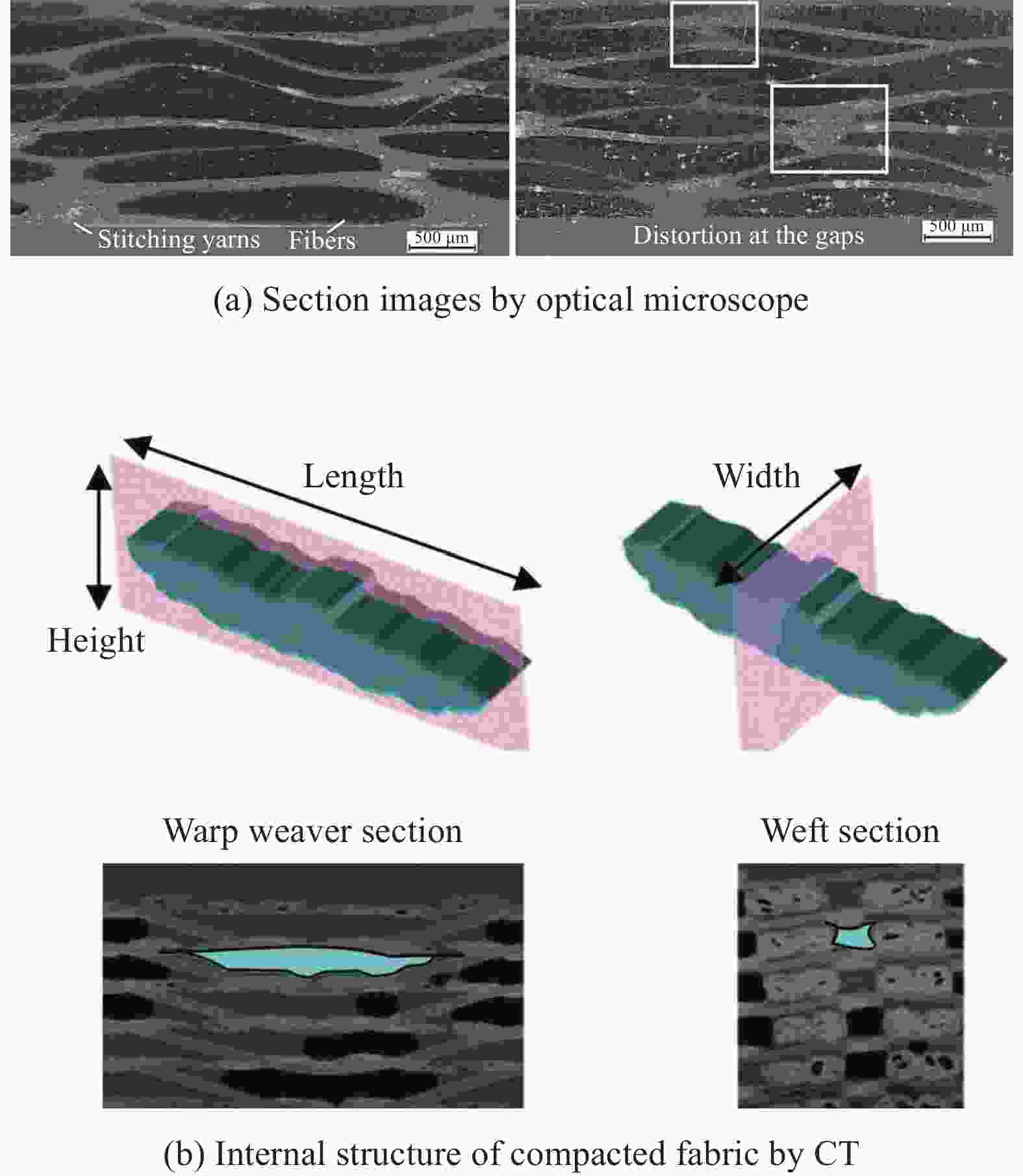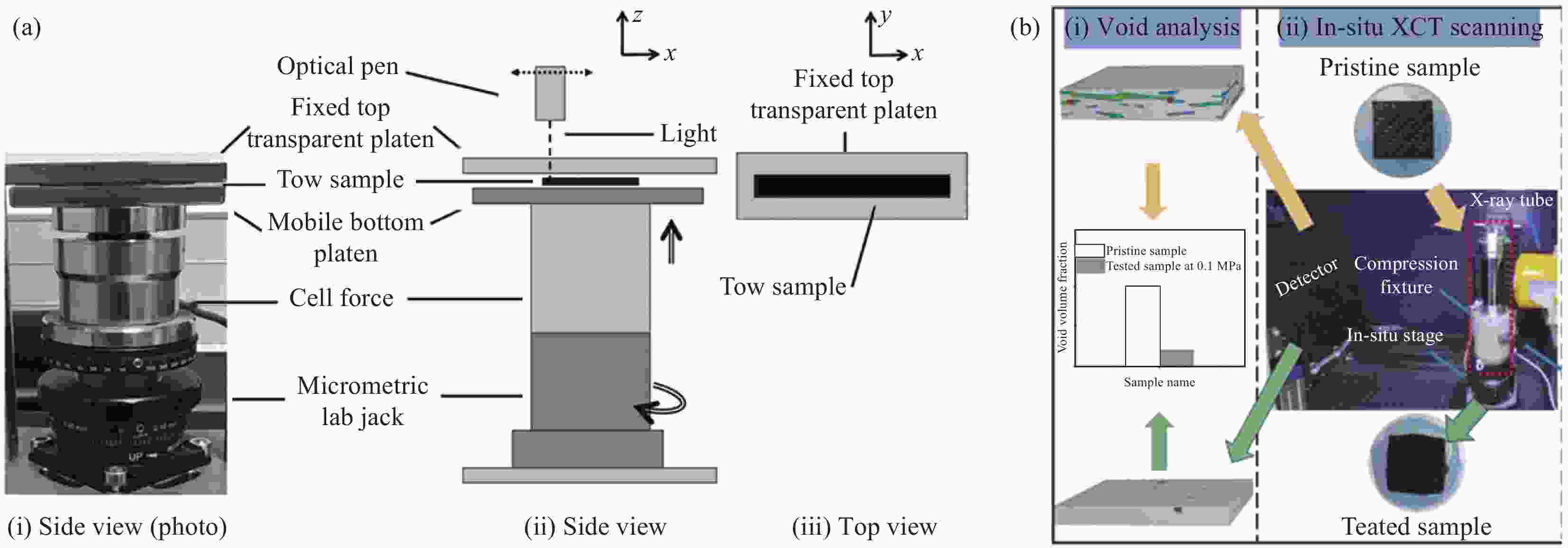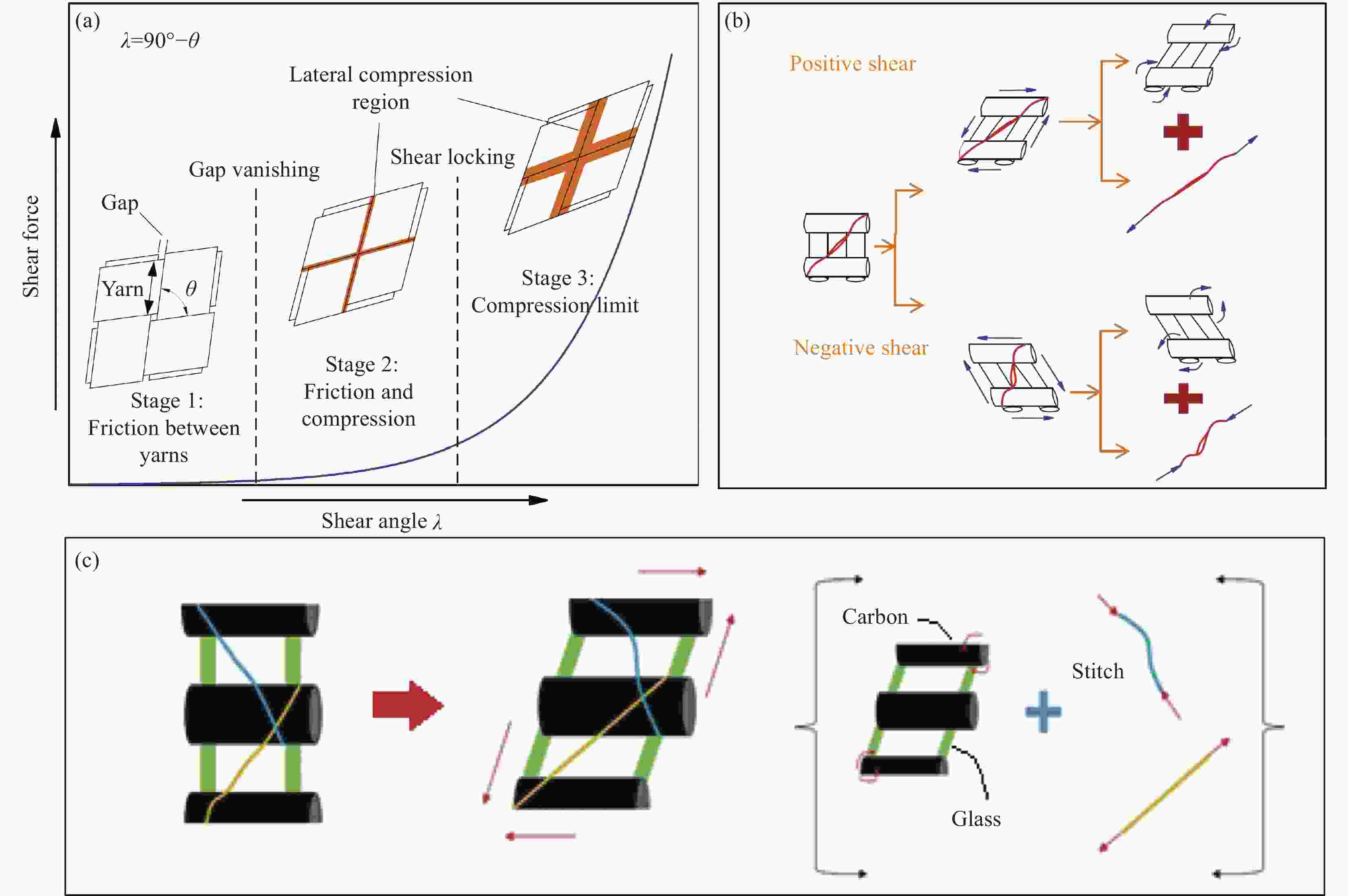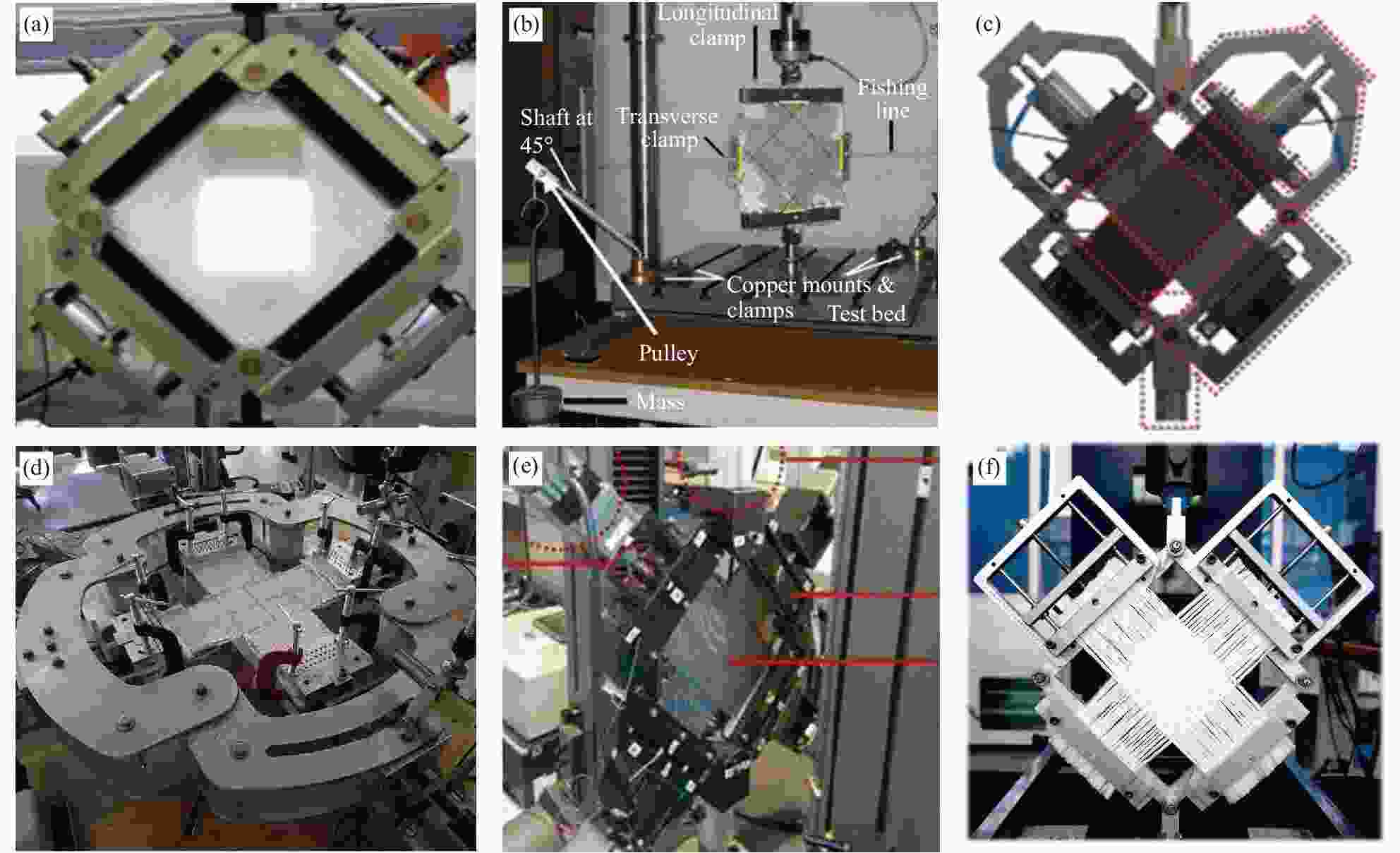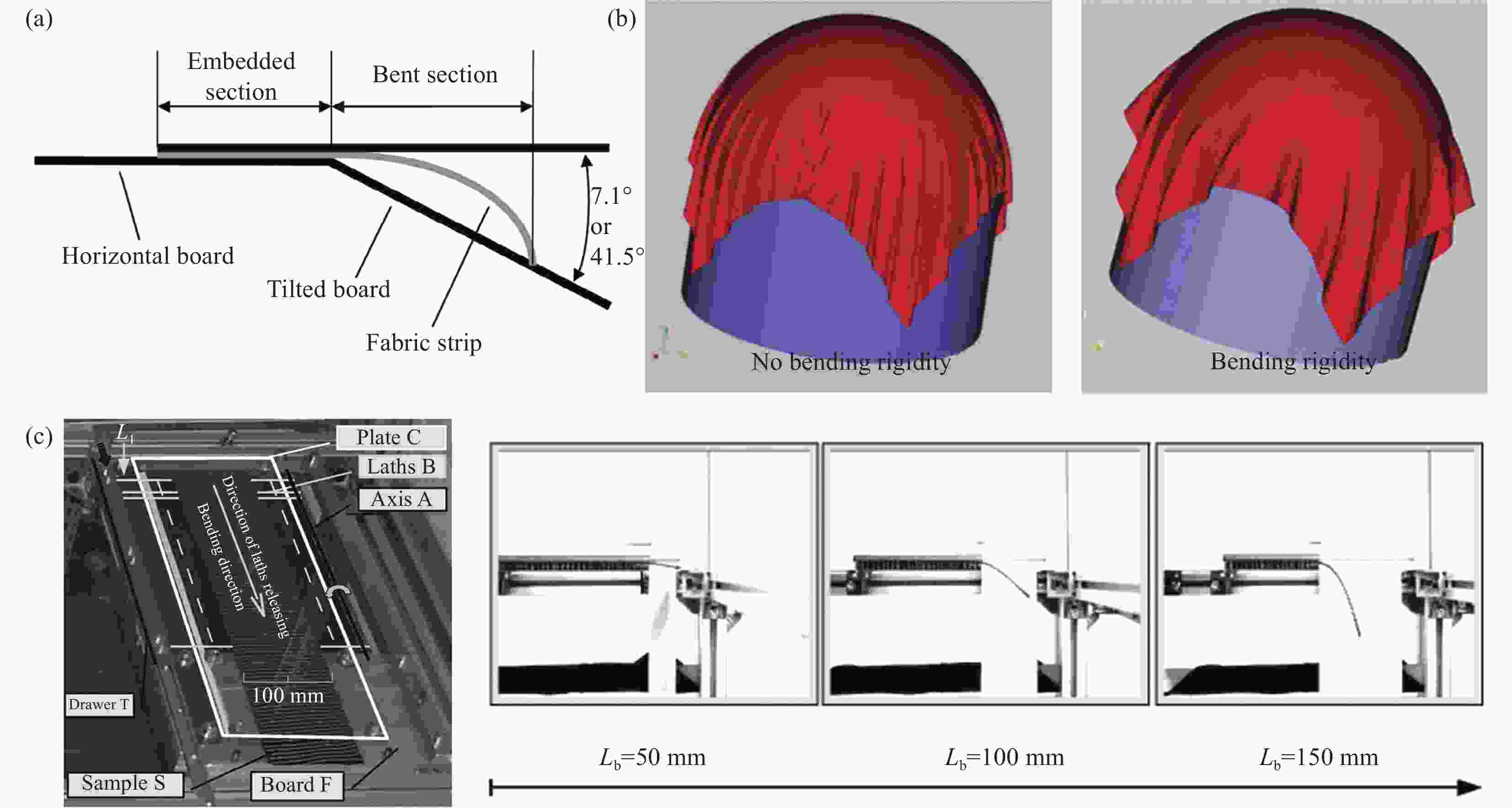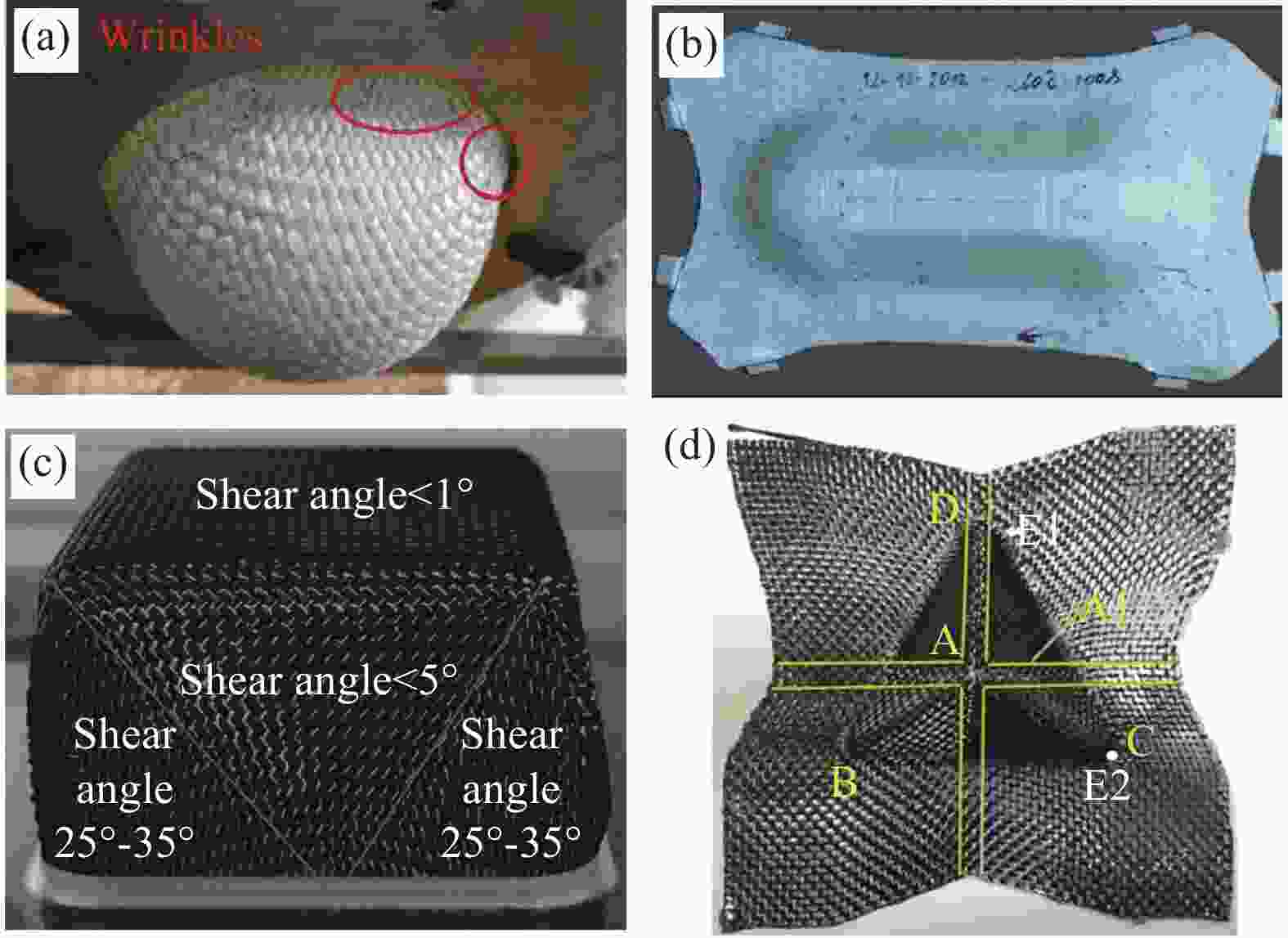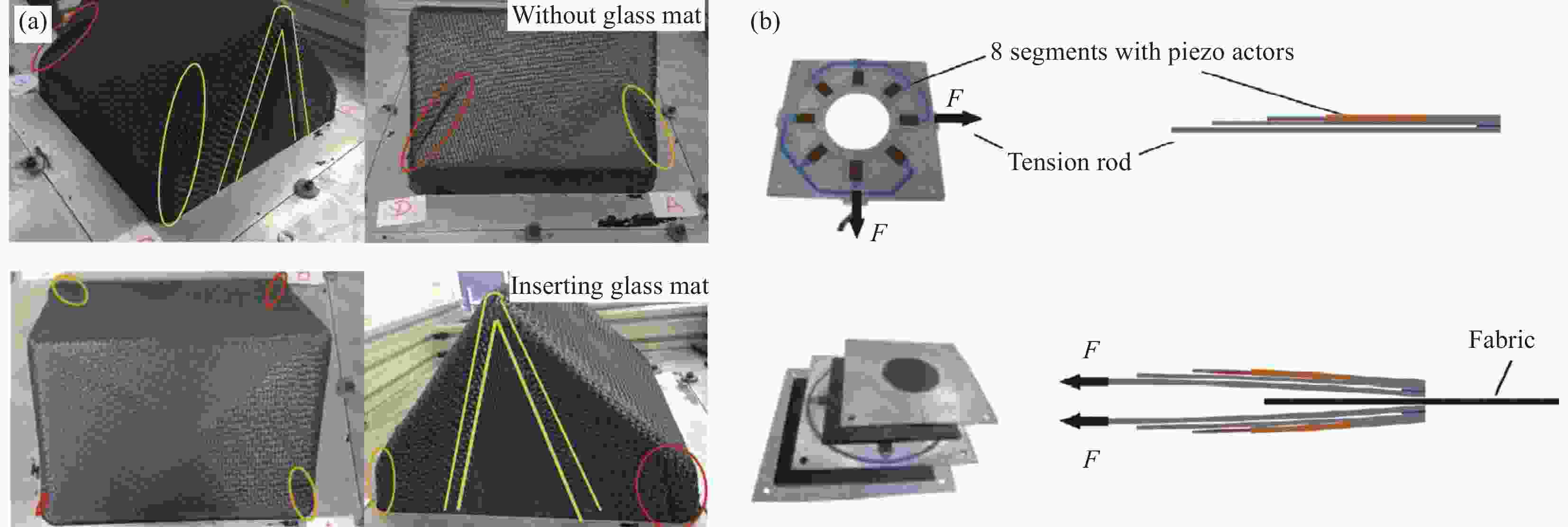Advance of fabric deformation in automated forming of fiber reinforced composites
-
摘要: 纤维增强树脂基复合材料具有高比强度和高比刚度等优异特性,被广泛应用于汽车领域以实现汽车轻量化。然而,纤维织物的多尺度特性使其在复杂形状的车身零部件成型中变形机制十分复杂,极易产生成型缺陷,削弱成型后的复合材料力学性能。表征织物变形特性,揭示织物变形机制,是准确预测织物复杂形状成型,指导织物成型工艺参数合理设计的重要基础。因此,本文针对织物在成型过程中的压缩、剪切、弯曲和滑移4种关键变形特性及在复杂几何形状中成型特性的研究进展进行综述,详细介绍了织物上述变形和成型特性的研究方法及研究热点。本文将为织物的变形机制研究、复杂形状成型精准预测和工艺参数合理设计提供指导,推动复合材料在汽车领域中的大规模应用。Abstract: Fiber reinforced composites are broadly used in the vehicle industry to realize the lightweight of automobile, due to its excellent performances such as high specific strength and stiffness. However, the multiscale nature of fabric results in the extremely complicated deformation mechanism of fabric in the forming of automobile component with complex shape. Characterization of fabric deformation behavior and revealing the fabric deformation mechanism, is the foundation that accurately predicts the fabric forming in the complex shape and guides the reasonable design of process parameters. Therefore, in this paper, four key deformation modes of fabric in the forming including compaction, shearing, bending and sliding are reviewed. In addition, the draping behavior in the complex shape forming is also reviewed. The research methods and focuses of deformation and draping behavior are introduced in detail. This paper will provide guidance for the research of fabric deformation mecha-nism, accurate prediction of fabric in complex shape forming, and the reasonable design of process parameters. These will promote the large-scale application of composites in the automotive field.
-
Key words:
- composite forming /
- fabric deformation mechanism /
- compaction /
- shearing /
- bending /
- sliding /
- complex shape forming
-
图 9 不同结构织物细观变形机制示意图:(a)平纹机织织物[35];(b) ±45°双轴向无屈曲织物[43];(c)单轴向无屈曲织物[45]
θ—Angle between the yarns
Figure 9. Schematics of meso deformation mechanism for fabrics with different architectures: (a) Plain woven fabric[35]; (b) ±45° biaxial pillar non-crimp fabric[43]; (c) Unidirectional non-crimp fabric[45]
-
[1] 中华人民共和国国务院办公厅. 关于印发新能源汽车产业发展规划(2021-2035年)的通知[EB/OL]. (2020-11-02)[2022-05-01]. http://www.gov.cn/zhengce/content/202011/02/content_5556716.htmGeneral Office of the State Council of the People's Republic of China. Notice of the general office of the state council on printing and distributing the new energy vehicle industry development plan (2021-2035)[EB/OL]. (2020-11-02)[2022-05-01]. http://www.gov.cn/zhengce/content/2020-11/02/content_5556716.htm(in Chinese). [2] WITIK R A, PAYET J, MICHAUD V, et al. Assessing the life cycle costs and environmental performance of lightweight materials in automobile applications[J]. Compo-sites Part A: Applied Science and Manufacturing,2011,42(11):1694-1709. doi: 10.1016/j.compositesa.2011.07.024 [3] XIE N, SMITH R A, MUKHOPADHYAY S, et al. A numerical study on the influence of composite wrinkle defect geometry on compressive strength[J]. Materials & Design, 2018, 140: 7-20. [4] RASHIDI A, MILANI A S. Assive control of wrinkles in woven fabric preforms using a geometrical modification of blank holders[J]. Composites Part A: Applied Science & Manufacturing,2018,105:300-309. [5] 杨志, 焦亚男, 谢军波, 等. 纺织复合材料纤维预制体力学性能测试方法研究进展[J]. 复合材料学报, 2022, 39(4):1511-1533. doi: 10.13801/j.cnki.fhclxb.20210820.001YANG Zhi, JIAO Yanan, XIE Junbo, et al. Research progress in testing methods of mechanical properties of textile composite fiber preforms[J]. Acta Materiae Compositae Sinica,2022,39(4):1511-1533(in Chinese). doi: 10.13801/j.cnki.fhclxb.20210820.001 [6] YOUSAF Z, POTLURI P, WITHERS P J. Influence of tow architecture on compaction and nesting in textile preforms[J]. Applied Composite Materials,2016,24(2):337-350. [7] RENAUD J, VERNET N, RUIZ E, et al. Creep compaction behavior of 3D carbon interlock fabrics with lubrication and temperature[J]. Composites Part A: Applied Science and Manufacturing,2016,86:87-96. doi: 10.1016/j.compositesa.2016.04.017 [8] 蒋建军, 陈星, 邓国力, 等. 嵌套效应对单向织物压缩行为的影响[J]. 复合材料学报, 2017, 34(11):2463-2472. doi: 10.13801/j.cnki.fhclxb.20170307.001JIANG Jianjun, CHEN Xing, DENG Guoli, et al. Effect of nesting on the compaction behavior of unidirectional fabrics[J]. Acta Materiae Compositae Sinica,2017,34(11):2463-2472(in Chinese). doi: 10.13801/j.cnki.fhclxb.20170307.001 [9] DANZI M, SCHNEEBERGER C, ERMANNI P. A model for the time-dependent compaction response of woven fiber textiles[J]. Composites Part A: Applied Science and Manufacturing, 2018, 105: 180-188. [10] MEI M, SUN L, HE Y, et al. Preforming characteristics in compaction process for fabric with binder under elevated temperature[J]. Composites Communications,2020,23:100545. [11] SOMASHEKAR A, BICKERTON S, BHATTACHARYYA D. Exploring the non-elastic compression deformation of dry glass fibre reinforcements[J]. Composites Science and Technology,2007,67(2):183-200. doi: 10.1016/j.compscitech.2006.07.032 [12] VERNET N, TROCHU F. Analysis and modeling of 3D interlock fabric compaction behavior[J]. Composites Part A: Applied Science and Manufacturing, 2016, 80: 182-193. [13] LI L, ZHAO Y, YANG J, et al. An experimental investigation of compaction behavior of carbon non-crimp fabrics for liquid composite molding[J]. Journal of Materials Science,2015,50(7):2960-2972. doi: 10.1007/s10853-015-8860-0 [14] SOMASHEKAR A, BICKERTON S, BHATTACHARYYA D. An experimental investigation of non-elastic deformation of fibrous reinforcements in composites manufacturing[J]. Composites Part A: Applied Science and Manufacturing,2006,37(6):858-867. doi: 10.1016/j.compositesa.2005.06.012 [15] LOMOV S V, BARBURSKI M, STOILOVA T, et al. Carbon composites based on multiaxial multiply stitched preforms. Part 3: Biaxial tension, picture frame and compression tests of the preforms[J]. Composites Part A: Applied Science and Manufacturing,2005,36(9):1188-1206. doi: 10.1016/j.compositesa.2005.01.015 [16] GRIESER T, MITSCHANG P. Investigation of the compaction behavior of carbon fiber NCF for continuous preforming processes[J]. Polymer Composites,2017,38(11):2609-2625. doi: 10.1002/pc.23854 [17] MAHADIK Y, BROWN K A R, HALLETT S R. Characterisation of 3D woven composite internal architecture and effect of compaction[J]. Composites Part A: Applied Science and Manufacturing,2010,41(7):872-880. doi: 10.1016/j.compositesa.2010.02.019 [18] DHARMALINGAM A S, HEMMER J, LECTEZ A S, et al. Evolution of single carbon and glass fibrous tow cross-sections in dry and lubricated states during compaction perpendicular to the fibers[J]. Composites Part B: Engi-neering,2018,148:235-242. doi: 10.1016/j.compositesb.2018.05.001 [19] ALAHMED N, NARESH K, KHAN K A, et al. In-situ X-ray computed tomography characterization of compaction-creep-recovery response and statistical void analysis of carbon/epoxy prepregs[J]. Composites Communications,2022,31:101117. doi: 10.1016/j.coco.2022.101117 [20] WIJAYA W, BICKERTON S, KELLY P A. Meso-scale compaction simulation of multi-layer 2D textile reinforcements: A Kirchhoff-based large-strain non-linear elastic constitutive tow model[J]. Composites Part A: Applied Science and Manufacturing,2020,137:106017. doi: 10.1016/j.compositesa.2020.106017 [21] YOUSAF Z, POTLURI P, WITHERS P J, et al. Digital element simulation of aligned tows during compaction vali-dated by computed tomography (CT)[J]. International Journal of Solids and Structures,2018,154:78-87. doi: 10.1016/j.ijsolstr.2017.05.044 [22] THOMPSON A J, EL-SAID B, IVANOV D, et al. High fide-lity modelling of the compression behaviour of 2D woven fabrics[J]. International Journal of Solids and Structures,2018,154:104-113. doi: 10.1016/j.ijsolstr.2017.06.027 [23] WIJAYA W, ALI M A, UMER R, et al. An automatic methodology to CT-scans of 2D woven textile fabrics to structured finite element and voxel meshes[J]. Composites Part A: Applied Science and Manufacturing,2019,125:105561. doi: 10.1016/j.compositesa.2019.105561 [24] NGUYEN Q T, VIDAL-SALLÉ E, BOISSE P, et al. Mesoscopic scale analyses of textile composite reinforcement compaction[J]. Composites Part B: Engineering,2013,44(1):231-241. doi: 10.1016/j.compositesb.2012.05.028 [25] THOMPSON A J, EL-SAID B, BELNOUE J P H, et al. Modelling process induced deformations in 0/90 non-crimp fabrics at the meso-scale[J]. Composites Science and Technology,2018,168:104-110. doi: 10.1016/j.compscitech.2018.08.029 [26] YOUSAF Z, WITHERS P J, POTLURI P. Compaction, nesting and image based permeability analysis of multi-layer dry preforms by computed tomography (CT)[J]. Compo-site Structures,2021,263:113676. doi: 10.1016/j.compstruct.2021.113676 [27] SOMASHEKAR A A, BICKERTON S, BHATTACHARYYA D. Modelling the viscoelastic stress relaxation of glass fibre reinforcements under constant compaction strain during composites manufacturing[J]. Composites Part A: Applied Science and Manufacturing,2012,43(7):1044-1052. doi: 10.1016/j.compositesa.2012.02.004 [28] KIM Y R, MCCARTHY S P, FANUCCI J P. Compressibility and relaxation of fiber reinforcements during composite processing[J]. Polymer Composites,1991,12(1):13-19. doi: 10.1002/pc.750120104 [29] KELLY P A, UMER R, BICKERTON S. Viscoelastic response of dry and wet fibrous materials during infusion processes[J]. Composites Part A: Applied Science and Manufacturing,2006,37(6):868-873. doi: 10.1016/j.compositesa.2005.02.008 [30] WEI K, LIANG D, MEI M, et al. A viscoelastic model of compression and relaxation behaviors in preforming process for carbon fiber fabrics with binder[J]. Composites Part B: Engineering,2019,158:1-9. doi: 10.1016/j.compositesb.2018.09.038 [31] MEI M, HE Y, WEI K, et al. Modeling the temperature-dependent viscoelastic behavior of glass fabric with binder in the compaction process[J]. Polymer Composites,2021,42(6):3038-3050. doi: 10.1002/pc.26037 [32] BOISSE P, HAMILA N, GUZMAN-MALDONADO E, et al. The bias-extension test for the analysis of in-plane shear properties of textile composite reinforcements and prepregs: A review[J]. International Journal of Material Forming,2017,10(4):473-492. doi: 10.1007/s12289-016-1294-7 [33] GEREKE T, DÖBRICH O, HÜBNER M, et al. Experimental and computational composite textile reinforcement forming: A review[J]. Composites Part A: Applied Science and Manufacturing,2013,46:1-10. doi: 10.1016/j.compositesa.2012.10.004 [34] 罗锡林, 谭惠丰, 武国军, 等. 国产F-12芳纶织物面内剪切性能[J]. 复合材料学报, 2018, 35(3):591-598. doi: 10.13801/j.cnki.fhclxb.20170601.003LUO Xilin, TAN Huifeng, WU Guojun, et al. Experimental investigation of in-plane shear performance for F-12 aramid fabric[J]. Acta Materiae Compositae Sinica,2018,35(3):591-598(in Chinese). doi: 10.13801/j.cnki.fhclxb.20170601.003 [35] MEI M, HE Y, YANG X, et al. Meso/macro scale response of the comingled glass polypropylene 2-2 twill woven fabric under shear pre-tension coupling[J]. Composite Structures,2020,236:111854. doi: 10.1016/j.compstruct.2020.111854 [36] CAO J, AKKERMAN R, BOISSE P, et al. Characterization of mechanical behavior of woven fabrics: Experimental methods and benchmark results[J]. Composites Part A: Applied Science and Manufacturing,2008,39(6):1037-1053. doi: 10.1016/j.compositesa.2008.02.016 [37] ZHU B, YU T X, TAO X M. An experimental study of in-plane large shear deformation of woven fabric compo-site[J]. Composites Science and Technology,2007,67(2):252-261. doi: 10.1016/j.compscitech.2006.08.011 [38] NOSRAT-NEZAMI F, GEREKE T, EBERDT C, et al. Characterisation of the shear-tension coupling of carbon-fibre fabric under controlled membrane tensions for precise simulative predictions of industrial preforming processes[J]. Composites Part A: Applied Science and Manufacturing,2014,67:131-139. doi: 10.1016/j.compositesa.2014.08.030 [39] KASHANI M H, RASHIDI A, CRAWFORD B J, et al. Analysis of a two-way tension-shear coupling in woven fabrics under combined loading tests: Global to local transformation of non-orthogonal normalized forces and displacements[J]. Composites Part A: Applied Science and Manufacturing,2016,88:272-285. doi: 10.1016/j.compositesa.2016.06.004 [40] ZHU B, YU T X, TAO X M. Large deformation and slippage mechanism of plain woven composite in bias extension[J]. Composites Part A: Applied Science and Manufacturing,2007,38(8):1821-1828. doi: 10.1016/j.compositesa.2007.04.009 [41] HÄRTEL F, HARRISON P. Evaluation of normalisation methods for uniaxial bias extension tests on engineering fabrics[J]. Composites Part A: Applied Science and Manufacturing,2014,67:61-69. doi: 10.1016/j.compositesa.2014.08.011 [42] SHEN H, WANG P, LEGRAND X. In-plane shear characteristics during the forming of tufted carbon woven fabrics[J]. Composites Part A: Applied Science and Manufacturing,2021,141:106196. doi: 10.1016/j.compositesa.2020.106196 [43] CHEN S, MCGREGOR O P L, HARPER L T, et al. Defect formation during preforming of a bi-axial non-crimp fabric with a pillar stitch pattern[J]. Composites Part A: Applied Science and Manufacturing,2016,91:156-167. doi: 10.1016/j.compositesa.2016.09.016 [44] MEI M, HE Y, YANG X, et al. Shear deformation characteristics and defect evolution of the biaxial ±45° and 0/90° glass non-crimp fabrics[J]. Composites Science and Technology,2020,193:108137. doi: 10.1016/j.compscitech.2020.108137 [45] MEHDI G, ELEAZAR A T, VALTER C, et al. Deformation characteristics and formability of a tricot-stitched carbon fiber unidirectional non-crimp fabric[J]. Composites Part A: Applied Science and Manufacturing,2021,145:106366. doi: 10.1016/j.compositesa.2021.106366 [46] LEE J S, HONG S J, YU W R, et al. The effect of blank holder force on the stamp forming behavior of non-crimp fabric with a chain stitch[J]. Composites Science and Technology,2007,67(3):357-366. [47] NOSRAT-NEZAMI F, GEREKE T, CHERIF C. Analyses of interaction mechanisms during forming of multilayer carbon woven fabrics for composite applications[J]. Composites Part A: Applied Science and Manufacturing,2016,84:406-416. doi: 10.1016/j.compositesa.2016.02.023 [48] LAUNAY J, HIVET G, DUONG A V, et al. Experimental analysis of the influence of tensions on in plane shear behaviour of woven composite reinforcements[J]. Composites Science and Technology,2008,68(2):506-515. doi: 10.1016/j.compscitech.2007.06.021 [49] HARRISON P, ABDIWI F, GUO Z, et al. Characterising the shear-tension coupling and wrinkling behaviour of woven engineering fabrics[J]. Composites Part A: Applied Science and Manufacturing,2012,43(6):903-914. doi: 10.1016/j.compositesa.2012.01.024 [50] HOSSEINI A, KASHANI M H, SASSANI F, et al. Identifying the distinct shear wrinkling behavior of woven composite preforms under bias extension and picture frame tests[J]. Composite Structures,2018,185:764-773. doi: 10.1016/j.compstruct.2017.11.033 [51] ZHAO X, LIU G, GONG M, et al. Effect of tackification on in-plane shear behaviours of biaxial woven fabrics in bias extension test: Experiments and finite element modeling[J]. Composites Science and Technology,2018,159:33-41. doi: 10.1016/j.compscitech.2018.02.016 [52] POPPE C, DÖRR D, HENNING F, et al. Experimental and numerical investigation of the shear behaviour of infiltrated woven fabrics[J]. Composites Part A: Applied Science and Manufacturing,2018,114:327-337. doi: 10.1016/j.compositesa.2018.08.018 [53] BAUMARD T, MENARY G, DE-ALMEIDA O, et al. Experimental characterization and modeling of the tempera-ture and rate-dependent shear behaviour of powder-impregnated glass fiber/PA66 woven semipregs[J]. Composites Science and Technology,2019,180:23-32. doi: 10.1016/j.compscitech.2019.05.011 [54] GUZMAN-MALDONADO E, HAMILA N, BOISSE P, et al. Thermomechanical analysis, modelling and simulation of the forming of pre-impregnated thermoplastics compo-sites[J]. Composites Part A: Applied Science and Manufacturing,2015,78:211-222. doi: 10.1016/j.compositesa.2015.08.017 [55] HARRISON P, CLIFFORD M J, LONG A C. Shear characterisation of viscous woven textile composites: A comparison between picture frame and bias extension experiments[J]. Composites Science and Technology,2004,64(10):1453-1465. [56] HAANAPPEL S P, TEN-THIJE R H W, SACHS U, et al. Formability analyses of uni-directional and textile reinforced thermoplastics[J]. Composites Part A: Applied Science and Manufacturing,2014,56:80-92. doi: 10.1016/j.compositesa.2013.09.009 [57] WANG P, HAMILA N, PINEAU P, et al. Thermomechanical analysis of thermoplastic composite prepregs using bias-extension test[J]. Journal of Thermoplastic Compo-site Materials,2012,27(5):679-698. [58] BOISSE P, COLMARS J, HAMILA N, et al. Bending and wrinkling of composite fiber preforms and prepregs: A review and new developments in the draping simulations[J]. Composites Part B: Engineering,2018,141:234-249. doi: 10.1016/j.compositesb.2017.12.061 [59] ALSHAHRANI H, HOJJATI M. Bending behavior of multilayered textile composite prepregs: Experiment and finite element modeling[J]. Materials & Design,2017,124:211-224. [60] LIANG B, HAMILA N, PEILLON M, et al. Analysis of thermoplastic prepreg bending stiffness during manufacturing and of its influence on wrinkling simulations[J]. Composites Part A: Applied Science and Manufacturing,2014,67:111-122. doi: 10.1016/j.compositesa.2014.08.020 [61] BOISSE P, HAMILA N, VIDAL-SALLÉ E, et al. Simulation of wrinkling during textile composite reinforcement forming: Influence of tensile, in-plane shear and bending stiffnesses[J]. Composites Science and Technology,2011,71(5):683-692. doi: 10.1016/j.compscitech.2011.01.011 [62] YU F, CHEN S, VIISAINEN J V, et al. A macroscale finite element approach for simulating the bending behaviour of biaxial fabrics[J]. Composites Science and Technology,2020,191:108078. doi: 10.1016/j.compscitech.2020.108078 [63] YU F, CHEN S, HARPER L T, et al. Simulating the effect of fabric bending stiffness on the wrinkling behaviour of biaxial fabrics during preforming[J]. Composites Part A: Applied Science and Manufacturing,2021,143:106308. doi: 10.1016/j.compositesa.2021.106308 [64] HAN M G, CHANG S H. Draping simulations of carbon/epoxy fabric prepregs using a non-orthogonal constitutive model considering bending behavior[J]. Composites Part A: Applied Science and Manufacturing,2021,148:106483. doi: 10.1016/j.compositesa.2021.106483 [65] DE BILBAO E, SOULAT D, HIVET G, et al. Experimental study of bending behaviour of reinforcements[J]. Experimental Mechanics,2010,50(3):333-351. doi: 10.1007/s11340-009-9234-9 [66] LOMOV S V, VERPOEST I, BARBURSKI M, et al. Carbon composites based on multiaxial multiply stitched preforms. Part 2. KES-F characterisation of the deformability of the preforms at low loads[J]. Composites Part A: Applied Science and Manufacturing,2003,34(4):359-370. doi: 10.1016/S1359-835X(03)00025-3 [67] CHARMETANT A, ORLIAC J G, VIDAL-SALLÉ E, et al. Hyperelastic model for large deformation analyses of 3D interlock composite preforms[J]. Composites Science and Technology,2012,72(12):1352-1360. doi: 10.1016/j.compscitech.2012.05.006 [68] MARGOSSIAN A, BEL S, HINTERHOELZL R. Bending characterisation of a molten unidirectional carbon fibre reinforced thermoplastic composite using a dynamic mechanical analysis system[J]. Composites Part A: Applied Science and Manufacturing,2015,77:154-163. doi: 10.1016/j.compositesa.2015.06.015 [69] POPPE C, ROSENKRANZ T, DÖRR D, et al. Comparative experimental and numerical analysis of bending behaviour of dry and low viscous infiltrated woven fabrics[J]. Composites Part A: Applied Science and Manufacturing,2019,124:105466. doi: 10.1016/j.compositesa.2019.05.034 [70] DANGORA L M, MITCHELL C, WHITE K D, et al. Characterization of temperature-dependent tensile and flexural rigidities of a cross-ply thermoplastic lamina with implementation into a forming model[J]. International Jour-nal of Material Forming,2018,11(1):43-52. doi: 10.1007/s12289-016-1327-2 [71] ALSHAHRANI H, HOJJATI M. A new test method for the characterization of the bending behavior of textile prepregs[J]. Composites Part A: Applied Science and Manufacturing,2017,97:128-140. doi: 10.1016/j.compositesa.2017.02.027 [72] LABANIEH A R, GARNIER C, OUAGNE P, et al. Intra-ply yarn sliding defect in hemisphere preforming of a woven preform[J]. Composites Part A: Applied Science and Manufacturing,2018,107:432-446. doi: 10.1016/j.compositesa.2018.01.018 [73] FETFATSIDIS K A, JAUFFRÈS D, SHERWOOD J A, et al. Characterization of the tool/fabric and fabric/fabric friction for woven-fabric composites during the thermostamping process[J]. International Journal of Material Forming,2013,6(2):209-221. doi: 10.1007/s12289-011-1072-5 [74] SACHS U, AKKERMAN R, FETFATSIDIS K, et al. Characterization of the dynamic friction of woven fabrics: Experimental methods and benchmark results[J]. Composites Part A: Applied Science and Manufacturing,2014,67:289-298. doi: 10.1016/j.compositesa.2014.08.026 [75] SMERDOVA O, SUTCLIFFE M P F. Multiscale tool-fabric contact observation and analysis for composite fabric forming[J]. Composites Part A: Applied Science and Manufacturing,2015,73:116-124. doi: 10.1016/j.compositesa.2015.03.009 [76] MONTERO L, ALLAOUI S, HIVET G. Characterisation of the mesoscopic and macroscopic friction behaviours of glass plain weave reinforcement[J]. Composites Part A: Applied Science and Manufacturing,2017,95:257-266. doi: 10.1016/j.compositesa.2017.01.022 [77] AVGOULAS E I, MULVIHILL D M, ENDRUWEIT A, et al. Frictional behaviour of non-crimp fabrics (NCFs) in contact with a forming tool[J]. Tribology International,2018,121:71-77. doi: 10.1016/j.triboint.2018.01.026 [78] ALLAOUI S, HIVET G, BILLOËT J L. Experimental analy-sis of the contact between layers of dry fabrics[J]. International Journal of Material Forming,2009,2(1):209. [79] ALLAOUI S, CELLARD C, HIVET G. Effect of inter-ply sliding on the quality of multilayer interlock dry fabric preforms[J]. Composites Part A: Applied Science and Manufacturing,2015,68:336-345. doi: 10.1016/j.compositesa.2014.10.017 [80] HIVET G, ALLAOUI S, CAM B T, et al. Design and potentiality of an apparatus for measuring yarn/yarn and fabric/fabric friction[J]. Experimental Mechanics,2012,52(8):1123-1136. doi: 10.1007/s11340-011-9566-0 [81] ALLAOUI S, HIVET G, WENDLING A, et al. Influence of the dry woven fabrics meso-structure on fabric/fabric contact behavior[J]. Journal of Composite Materials,2012,46(6):627-639. doi: 10.1177/0021998311424627 [82] NAJJAR W, PUPIN C, LEGRAND X, et al. Analysis of frictional behaviour of carbon dry woven reinforcement[J]. Journal of Reinforced Plastics and Composites,2014,33(11):1037-1047. doi: 10.1177/0731684414521670 [83] YU F, CHEN S, HARPER L T, et al. Investigation into the effects of inter-ply sliding during double diaphragm forming for multi-layered biaxial non-crimp fabrics[J]. Composites Part A: Applied Science and Manufacturing,2021,150:106611. doi: 10.1016/j.compositesa.2021.106611 [84] 孔令国, 王继辉, 陈宏达, 等. 压边力对非平衡平纹机织物预制体成型作用规律[J]. 复合材料学报, 2022, 39(4):1798-1812.KONG Lingguo, WANG Jihui, CHEN Hongda, et al. Influence of blank-holder force on the draping process of unbalanced plain woven fabric preform[J]. Acta Materiae Compositae Sinica,2022,39(4):1798-1812(in Chinese). [85] PENG X, GUO Z, DU T, et al. A simple anisotropic hyperelastic constitutive model for textile fabrics with application to forming simulation[J]. Composites Part B: Engi-neering,2013,52:275-281. doi: 10.1016/j.compositesb.2013.04.014 [86] WANG P, LEGRAND X, BOISSE P, et al. Experimental and numerical analyses of manufacturing process of a composite square box part: Comparison between textile reinforcement forming and surface 3D weaving[J]. Compo-sites Part B: Engineering,2015,78:26-34. doi: 10.1016/j.compositesb.2015.03.072 [87] YAO Y, PENG X, GONG Y. Influence of tension-shear coupling on draping of plain weave fabrics[J]. Journal of Materials Science,2019,54(8):6310-6322. doi: 10.1007/s10853-019-03334-w [88] HARRISON P, GOMES R, CURADO-CORREIA N. Press forming a 0/90 cross-ply advanced thermoplastic composite using the double-dome benchmark geometry[J]. Composites Part A: Applied Science and Manufacturing,2013,54:56-69. doi: 10.1016/j.compositesa.2013.06.014 [89] 丁纺纺, 彭雄奇. 复合材料用机织物非正交本构模型的半球形冲压成型验证[J]. 复合材料学报, 2011, 28(1):156-160. doi: 10.13801/j.cnki.fhclxb.2011.01.024DING Fangfang, PENG Xiongqi. Validation of a non-orthogonal constitutive model for woven composite fabrics via hemispherical stamping simulation[J]. Acta Materiae Compositae Sinica,2011,28(1):156-160(in Chinese). doi: 10.13801/j.cnki.fhclxb.2011.01.024 [90] OUAGNE P, SOULAT D, MOOTHOO J, et al. Complex shape forming of a flax woven fabric: Analysis of the tow buckling and misalignment defect[J]. Composites Part A: Applied Science and Manufacturing,2013,51:1-10. doi: 10.1016/j.compositesa.2013.03.017 [91] SALEM M M, DE-LUYCKER E, FAZZINI M, et al. Experimental, analytical and numerical investigation to prevent the tow buckling defect during fabric forming[J]. Composites Part A: Applied Science and Manufacturing,2019,125:105567. doi: 10.1016/j.compositesa.2019.105567 [92] XIAO S, WANG P, SOULAT D, et al. Towards the deformability of triaxial braided composite reinforcement during manufacturing[J]. Composites Part B: Engineering,2019,169:209-220. doi: 10.1016/j.compositesb.2019.04.017 [93] XIAO S, WANG P, SOULAT D, et al. An exploration of the deformability behaviours dominated by braiding angle during the forming of the triaxial carbon fibre braids[J]. Composites Part A: Applied Science and Manufacturing,2020,133:105890. doi: 10.1016/j.compositesa.2020.105890 [94] VIISAINEN J V, HOSSEINI A, SUTCLIFFE M P F. Experimental investigation, using 3D digital image correlation, into the effect of component geometry on the wrinkling behaviour and the wrinkling mechanisms of a biaxial NCF during preforming[J]. Composites Part A: Applied Science and Manufacturing,2021,142:106248. doi: 10.1016/j.compositesa.2020.106248 [95] SCHIRMAIER F J, WEIDENMANN K A, KÄRGER L, et al. Characterisation of the draping behaviour of unidirectional non-crimp fabrics (UD-NCF)[J]. Composites Part A: Applied Science and Manufacturing,2016,80:28-38. doi: 10.1016/j.compositesa.2015.10.004 [96] ALLAOUI S, HIVET G, SOULAT D, et al. Experimental preforming of highly double curved shapes with a case corner using an interlock reinforcement[J]. International Journal of Material Forming,2012,7(2):155-165. [97] GUZMAN-MALDONADO E, WANG P, HAMILA N, et al. Experimental and numerical analysis of wrinkling during forming of multi-layered textile composites[J]. Compo-site Structures,2019,208:213-223. doi: 10.1016/j.compstruct.2018.10.018 [98] CAPELLE E, OUAGNE P, SOULAT D, et al. Complex shape forming of flax woven fabrics: Design of specific blank-holder shapes to prevent defects[J]. Composites Part B: Engineering,2014,62:29-36. doi: 10.1016/j.compositesb.2014.02.007 [99] CHEN S, HARPER L T, ENDRUWEIT A, et al. Formability optimisation of fabric preforms by controlling material draw-in through in-plane constraints[J]. Composites Part A: Applied Science and Manufacturing,2015,76:10-19. doi: 10.1016/j.compositesa.2015.05.006 [100] CHEN S, MCGREGOR O P L, HARPER L T, et al. Optimisation of local in-plane constraining forces in double diaphragm forming[J]. Composite Structures,2018,201:570-581. doi: 10.1016/j.compstruct.2018.06.062 [101] TURK M A, VERMES B, THOMPSON A J, et al. Mitigating forming defects by local modification of dry preforms[J]. Composites Part A: Applied Science and Manufacturing,2020,128:105643. doi: 10.1016/j.compositesa.2019.105643 [102] MOLNÁR P, OGALE A, LAHR R, et al. Influence of drapability by using stitching technology to reduce fabric deformation and shear during thermoforming[J]. Compo-sites Science and Technology,2007,67(15):3386-3393. [103] LIU L, ZHANG T, WANG P, et al. Influence of the tufting yarns on formability of tufted 3-dimensional composite reinforcement[J]. Composites Part A: Applied Science and Manufacturing,2015,78:403-411. doi: 10.1016/j.compositesa.2015.07.014 [104] SHANWAN A, ALLAOUI S. Different experimental ways to minimize the preforming defects of multi-layered interlock dry fabric[J]. International Journal of Material Forming,2019,12:69-78. doi: 10.1007/s12289-018-1407-6 [105] NOSRAT-NEZAMI F N, GEREKE T, CHERIF C. Active forming manipulation of composite reinforcements for the suppression of forming defects[J]. Composites Part A: Applied Science and Manufacturing,2017,99:94-101. doi: 10.1016/j.compositesa.2017.04.011 [106] PHILIPPE B, NUNO C. Numerical forming of continuous fibre reinforced composite material: A review[J]. Composites Part A: Applied Science and Manufacturing,2018,113:12-31. doi: 10.1016/j.compositesa.2018.07.010 [107] HEISEY F L, HALLER K D. Fitting woven fabric to surfaces in three dimensions[J]. The Journal of the Textile Institute,1988,79(2):250-263. doi: 10.1080/00405008808659140 [108] VAN DER WEEËN F. Algorithms for draping fabrics on doubly-curved surfaces[J]. International Journal for Numerical Methods in Engineering,1991,31(7):1415-1426. doi: 10.1002/nme.1620310712 [109] PICKETT A K, CREECH G, DE LUCA P. Simplified and advanced simulation methods for prediction of fabric draping[J]. Revue Européenne Des Éléments Finis,2005,14(6-7):677-691. [110] BEN BOUBAKER B, HAUSSY B, GANGHOFFER J F. Discrete models of woven structures: Macroscopic approach[J]. Composites Part B: Engineering,2007,38(4):498-505. doi: 10.1016/j.compositesb.2006.01.007 [111] DUHOVIC M, MITSCHANG P, BHATTACHARYYA D. Modelling approach for the prediction of stitch influence during woven fabric draping[J]. Composites Part A: Applied Science and Manufacturing,2011,42(8):968-978. doi: 10.1016/j.compositesa.2011.03.025 [112] SIRTAUTAS J, PICKETT A K, LÉPICIER P. A mesoscopic model for coupled drape-infusion simulation of biaxial non-crimp fabric[J]. Composites Part B: Engineering, 2013, 47: 48-57. [113] XUE P, PENG X, CAO J. A non-orthogonal constitutive model for characterizing woven composites[J]. Compo-sites Part A: Applied Science and Manufacturing,2003,34(2):183-193. doi: 10.1016/S1359-835X(02)00052-0 [114] BADEL P, GAUTHIER S, VIDAL-SALLÉ E, et al. Rate constitutive equations for computational analyses of textile composite reinforcement mechanical behaviour during forming[J]. Composites Part A: Applied Science and Manufacturing,2009,40(8):997-1007. doi: 10.1016/j.compositesa.2008.04.015 [115] GONG Y, PENG X, YAO Y, et al. An anisotropic hyperelastic constitutive model for thermoplastic woven composite prepregs[J]. Composites Science and Technology,2016,128:17-24. doi: 10.1016/j.compscitech.2016.03.005 -






 下载:
下载:

